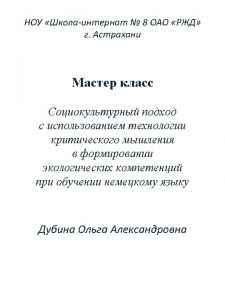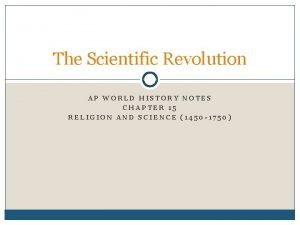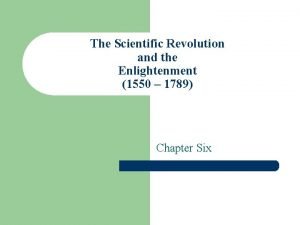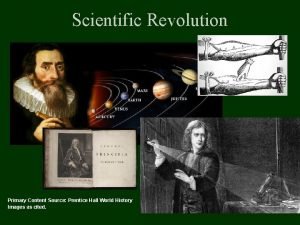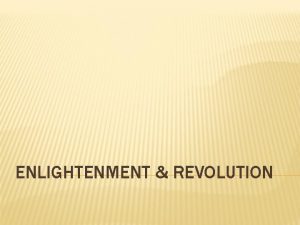Scientific Revolution Eise Eisinga Introduction magister Eise Eisinga








- Slides: 8

Scientific Revolution

Eise Eisinga • • • Introduction, magister Eise Eisinga Scientific Revolution Recap Ending Eise Eisinga • 21 february 1744 - 27 august 1828 Franeker • Wool combing • Learned through self-study • At the age of 15 he wrote his first Math’s book • At the age of 17 he wrote his first book on astronomy • Build a planetarium that is still working

Scientific Revolution • • • Introduction, magister Eise Eisinga Scientific Revolution Recap Ending Old Greek scientific thinking: Natural Philosophy or the study of nature • Ptolemaeus (Astronomy – earth in centre) • Galenus (Anatomy – Balance in body Liquids) Middle Ages: Fall of the West Roman Empire (500) Scientific discoveries in Arabia (700 – 1500) Renaissance: No longer would the world be explained through the Bible, but through research as the ancient Greeks had done. Fall of Constantinopel (1453) Printing Press Rationalism

Recap

Scientific Revolution Science in the Republic: • • • Introduction, magister Eise Eisinga Scientific Revolution Recap Ending The Republic was popular because of the tolerance towards people who thought differently. Therefor the Republic drew in alot of important “Enlightened” thinkers. • René Decartes (math, physics and philosopher) • Hugo de Groot (international law) • Christiaan Huygens (math, physics, astronomy) • Galileo Galilei (telescope) • Antoni van Leeuwenhoek (microscope – discovered microorganisms) • Jan Swammerdam (improved microscope and discovered blood cells) • Simon Steven (decimal system) • Jan Adriaanszoon Leeghwater (inpoldering)

Scientific Revolution • • • Introduction, magister Eise Eisinga Scientific Revolution Recap Ending Reaction of the Church and Governments • The idea of modern science was that God created earth and the natural laws but no longer intervened. • Governments and Church did not like the idea’s and banned books that were to critical. A Public Opinion forms • The Englightment was very popular with the Bourgeoisie, they came together in coffee houses, saloons and living rooms to read and discuss. A public opinion was formed. • The opinion of King and Church was no longer decisive. People now thought on their own.

Short Recap (Notes) • • • Introduction, magister Eise Eisinga Scientific Revolution Recap Ending Eise Eisinga: • Wool comber who created a planetarium Scientific Revolution: • Back to the way the ancient Greeks studied, by research and observation; • God created the Earth and the Natural Laws but no longer interfered; • Bourgeoisie started discussing and forming their own opinion, Public Opinion was formed; Why the Republic? • Because of the tolerance lots of exiled thinkers settled in the Republic and started publishing;

Ending Recreate Eise’s planetarium on paper! • • • Introduction, magister Eise Eisinga Scientific Revolution Recap Ending • Mercury, Venus, Earth, Mars, Jupiter, Saturn and the sun • Find examples of his Planetarium on the internet and recreate it on paper Or • Make your own Planetarium on paper
 Osterspaziergang vom eise befreit
Osterspaziergang vom eise befreit Russian revolution vs french revolution
Russian revolution vs french revolution Did american revolution cause french revolution
Did american revolution cause french revolution Modern commercial agriculture
Modern commercial agriculture A logical procedure for gathering and testing ideas
A logical procedure for gathering and testing ideas Scientific revolution ap world history
Scientific revolution ap world history Newton's first law of motion
Newton's first law of motion Johannes kepler prezi
Johannes kepler prezi Scientific revolution primary sources
Scientific revolution primary sources
